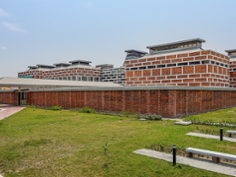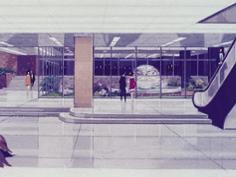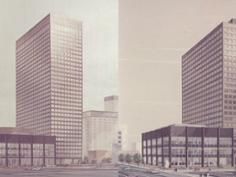
The Ground for Junglim's Half-centennial Growth:
Korea Exchange Bank Headquarters and Daegu Bank Headquarters
The Ground for Junglim Architecture to Grow: Korea Exchange Bank Headquarters and Daegu Bank Headquarters
Junglim Architecture began in 1967 with the name of Junglim Architecture Research Center, originally located at a former Japanese house in Eulji-ro 1-ga, Seoul. Working through the unstable political landscape and several times of economic crises in Korea, Junglim has grown steadily and settled literally as a leading architectural firm in the country. To this day, our guiding force has been to remain faithful to the "basics." We are here to ruminate upon the basics of this company, on top of which solid ground to put the new and build another half-century: the past fifty years, and the next fifty years to build!
As seen in a myriad of projects conducted, Junglim Architecture values the basics, which afford background for ceaseless endeavors to create the new. Underlying these attempts is the attitude of commitment to realizing the essence of architecture. As a group, an architectural firm should not only have design abilities, but also make harmony with such key elements as technology, efficient project management, and sound organizational operation: this is a precondition to complete "sound architecture." Likewise, Junglim has made various efforts so far to improve its key elements for sound architecture to the highest pitch.
The basics of Junglim Architecture are to be revealed by analyzing its representative works, which enable us to see how this company has blazed new trails through the Korean architectural design market which was once like a barren wilderness for the industry. They will also make it possible to estimate how to cope with and stand unchallenged in the present market which is changing day by day. Such basic works of Junglim include, amongst others, Korea Exchange Bank Headquarters (1977) and Daegu Bank Headquarters (1979). Recognized to have created the first of its kind in the 1970s when large-scale buildings were not commonplace, both projects have long been the model cases of bank architecture in Korea, and more significantly, paved the way for Junglim to grow into what it is today.
The Spirit of Endeavor, the Guiding Force of Junglim Architecture
The Korea Exchange Bank Headquarters is a realized project as the winner of a design competition in 1973. At the time when large-scale buildings were rarely found, the first priority for the design team to consider was the elements of sound architecture, such as how to make the relationship between architecture and the city, how to design the particular functions of bank architecture, and how to achieve energy-saving. As a consequence, the KEB Headquarters became a model case of bank architecture that since had much influence on other projects with similar scales and functions.
Taking the KEB Headquarters as a reference, the Daegu Bank Headquarters was designed by considering the local environment and focusing on the client's needs. The DB Headquarters is still used satisfactorily by the client as well as the local residents even though 30 years passed now since its completion. For about 20 years thereafter, Junglim has formulated a type of bank architecture by embodying the optimal functions and forms for bank into many buildings like the former Korea Long-term Credit Bank Headquarters (1975), the Export-Import Bank of Korea Headquarters (1982), Gyeonggi Bank Headquarters (1987), and Jeonbuk Bank Headquarters (1989).
As seen in the cases of bank architecture, Junglim has worked on various projects by ceaselessly and proactively researching without fear for the challenges of new programs and types. Our successful projects include Times Square, which is the first large-scale commercial complex in Korea, and Lotte World Shenyang, which pioneered the abroad architectural design market. In 2013, our other projects were successfully nominated as the final winners in two sections of the MIPIM Awards, the world-renowned real-estate development fair which has been held in Cannes, France, since 1990. Particularly, the MIPIM Awards 2013 was one of the biggest ever with participation of 175 projects from 45 countries, amongst which only 36 projects were able to become finalists and the two out of them were ours.
With the spirit of endeavor, Junglim Architecture is paying attention to environmentally friendly and BIM-based designs, which are essential for sound and efficient architecture, and striving to apply them to the design process along with the efforts of assembling professional human resources and establishing efficient systems.
Now then, what is the force of driving Junglim's spirit of endeavor without fear for the new? What "basics" enable Junglim to ceaselessly attempt challenging tasks? Analyzing the processes and outcomes of the KEB Headquarters and the DB Headquarters will help discuss the basics of Junglim Architecture.
“Junglim Architecture strives to make buildings lively over long time by detailed analysis of change."
- From Daegu Bank Report
Reconstructed excerpts from "Ruminating upon the basics of Junglim Architecture," Junglim Architecture Works 2013










